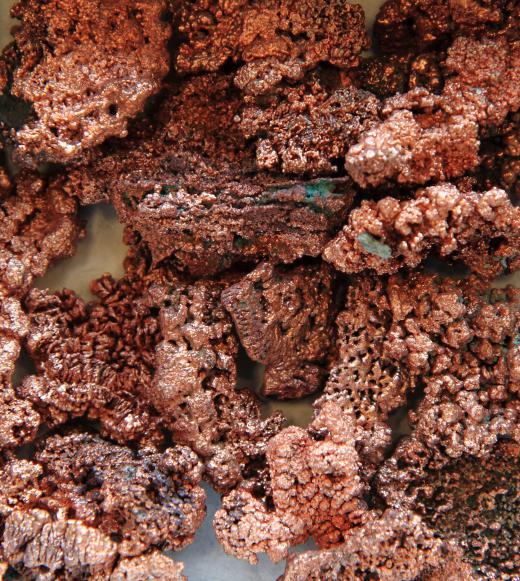At AboutMechanics, we're committed to delivering accurate, trustworthy information. Our expert-authored content is rigorously fact-checked and sourced from credible authorities. Discover how we uphold the highest standards in providing you with reliable knowledge.
What Is Involved in Smelting Ore?
Smelting ore is a process where rock containing metals in mineral form is heated, often with the addition of other chemicals or gasses, to separate out the native metal for further use and processing. Copper and silver are believed to have been the earliest metals ever smelted by humanity, and origins of the process can be traced back many thousands of years to the dawn of civilization. Early smelting of oxide-based ores such as iron involved the introduction of carbon into the smelting furnace in the form of charcoal, where the carbon would bind with the oxygen in the ore under high temperatures and free up the base metal. Many early ages in the advancement of civilization are named after the common smelting technology of the period, or lack thereof, such as the Stone Age, Bronze Age, and Iron Age.
A contemporary smelting furnace is typically a large, heat-treated steel reactor chamber lined with carbon and often known as a reduction cell. The chamber is heated to the melting point of the metal and it is reacted with chemicals that bind to its oxidizing agents. The metal is drained off, and the solid waste material, known as slag, is stored for safe disposal. Smelting techniques have been known to be heavy environmental polluters, as they can create wastewater and heavy metal contaminates such as arsenic, cadmium, and mercury, that pollute local waterways.

A common complaint of smelting ore has been that the equipment also creates dangerous air pollution that leads to acid rain. Potentially causing damage to the atmosphere in the form of sulphuric acid mist, the result of smelting metal sulfides is the emission of sulfur dioxide gas that reacts with the atmosphere. An example of this is copper sulfide, CuFeS2, which is smelted in much the same way as it was centuries ago. Acid rain is not only harmful to human and animal populations, but it can also increase the level of acidity in soil, as most plants cannot thrive in highly acidic environments. Modern smelting tools now involve the use of electrostatic precipitators that serve as air scrubbers to reduce emissions, and recycling of smelted wastewater back into the process instead of releasing it into the environment.

A newer method of smelting ore involves what is known as a flash furnace, which is used to smelt anything from copper to tin or aluminum. It is more of a closed environmental system than traditional smelters and largely exothermic, where the smelter generates heat through chemical reactions instead of primarily outsides sources. Alumina smelting ore is processed in this way into aluminum in a reaction cell that operates at temperatures from 1,778° to 2,102° Fahrenheit (970° to 1,150° Celsius). The reaction cell is also electrically charged, which helps to remove impurities and reacts the alumina with carbon to form aluminum and carbon dioxide.
The flash furnace gets its name from the process of smelting ore where the sulfur oxides in the ore are instantaneously converted to sulfur dioxide gas. This gas is siphoned off by new types of smelting tools in the furnace, stored, and sold for other industrial uses. While this increases smelting safety, the conversion to flash furnaces from older-style sintering and blast furnace designs for smelting ore only began to take place in the mid-1990s. Pollution is still a significant issue in the smelting industry, and the land around smelters has traditionally been a wasteland, where nothing natural would thrive.
AS FEATURED ON:
AS FEATURED ON:












Discuss this Article
Post your comments